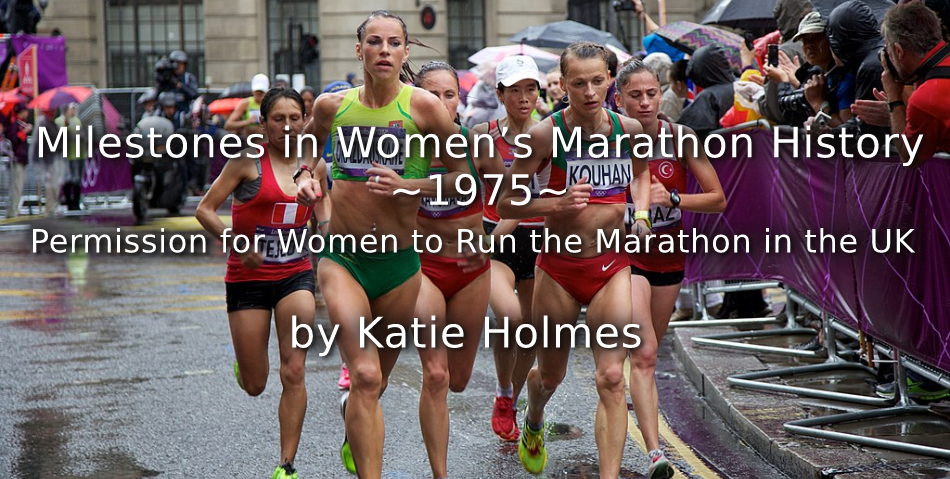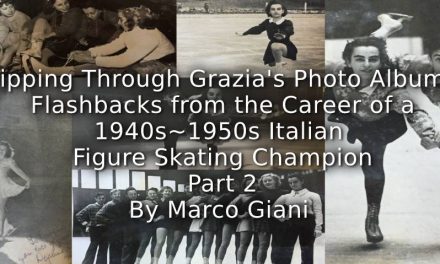Introduction
For most of the twentieth century the maximum distance that women were permitted to run in athletics competition was extremely limited. Until the late 1960s, when the 1500m was recognised by the International Amateur Athletic Federation (IAAF), the longest distance women ran in international track competition was 800 metres. International cross country races were up to 4 miles, but were usually shorter. There was no international road race competition for women.
The 1960s marked the quickening of a desire for women to be allowed to participate in the marathon and other road races. Women in several countries began to break the rules and compete in men-only races. In the 1970s, this desire, this demand, grew into organised campaigns.
In the USA, there was a campaign focused on the Boston Marathon, following Bobbi Gibb’s participation in 1966 and both Gibb’s and Kathrine Switzer’s participation in 1967. Women continued to run in the race without permission until the organisers finally admitted them in 1972 with the approval of the American Athletic Union (AAU). The AAU organised its first Women’s National Marathon Championship in 1974.
In 1971, the West German Deutscher Leicthathletik Verband (DLV) became the first national governing body worldwide to permit women to compete in a marathon, when it granted permission for women to run the Schwarzwald Marathon. Women had been competing semi-officially (with the race organiser’s co-operation) since the inception of the race in 1968. The DLV held its first Women’s National Marathon Championship in 1975.
The UK lagged behind these two countries. It was not until October 1975 that women in the UK were permitted to run further than 6000m (approximately 4 miles) in competition on any surface (track, road, cross country). The governing body for England and Wales, the Women’s Amateur Athletic Association (WAAA), agreed in principle at an Extraordinary General Meeting in April 1975 to arrange for “experimental rules” to be introduced. These rules permitted Senior women aged 21 and over to compete at the marathon distance, and younger women aged 17 and over to compete at a range of shorter distances in three age brackets. The first Women’s National Marathon Championship did not take place until 1978. (The first Northern Irish and Scottish Championships took place in 1982 and 1983 respectively.)
This tardiness seems at odds with the WAAA’s leading role in extending the distances that women ran on the track. It had pushed for both the 1500m and 3000m to be added to international competition. The WAAA incorporated both distances into its own championships many years before they were adopted internationally.
This article will look at the role of the WAAA and consider the factors which may have contributed to the delay in approving long-distance running for women in the UK.
The Women’s Amateur Athletic Association
The Women’s Amateur Athletic Association was formed in 1922 to meet a growing demand for organised competition for women. It might have become part of the Amateur Athletic Association, the governing body of men’s athletics established in 1880, but the AAA decided that there should be a separate body for women’s athletics rather than a unified one.
There were separate WAAAs in Scotland (established in 1930), Wales (1951) and Northern Ireland (1951). Although Wales had a separate governing body, it was agreed that it would fall into the jurisdiction of the WAAA. The Scottish and Northern Irish WAAAs remained independent.
The main athletics activities for women were track and field with cross country racing providing endurance training during the winter months. Track and road walking were also part of the competition programme. Some clubs organised women’s road running relays, typically with legs of up to two miles. Road races for women were very occasionally put on when a men’s race was taking place. They were always short distances, as the WAAA rules limited the distance for races to 6000m (approximately four miles)

Advertisement for Pencoed road races with 4 mile race for men and 1 mile races for women and boys
Source: Athletics Weekly, 7th April 1973
There were county, regional and national championships for track and field, cross country and race walking from the 1920s onwards. The relative unimportance of road racing in the WAAA programme is illustrated by the fact that the road relay did not become a national championship event until 1963 and distance racing until 1978, when the first WAAA National Marathon Championship was held.
The WAAA – conservative or forward-thinking?
Male athletics journalists and other prominent men involved in the sport often criticised the WAAA for being conservative and slow to change. In an article in The Guardian following the WAAA Track and Field Championships in July 1975, entitled “Women’s castle is now out of date”, John Rodda wrote:
The women’s AAA live in a well-fortified castle in which life goes on much as it has done for the past 20 or 30 years.
He concluded that it might be better if sponsors and TV were to withdraw their support for the Championships and “place the castle under siege, so that the sport could be restructured from the bottom by more enlightened people.”
The WAAA was run by long-serving volunteers and was led by women from the 1930s onwards (although it retained a male Chairman until 1973). It followed the example of the AAA in terms of governance structure and rules of competition and shared many of its underpinning values. The WAAA differed from the AAA in its concern for the welfare of the girls and young women who were competing. This concern is demonstrated in one of its founding objects (the AAA had no equivalent object):
The assurance that women should compete only in suitable surroundings and desirable conditions.
This object covered practical considerations such as the provision of separate and adequate changing facilities for women as well as the aim of protecting women from exploitation. The officers of the WAAA were only too aware of the scrutiny of women’s physical appearance and dress and how this could be represented in the press. For example, the rules about competition clothing, might have seemed conservative but they were probably driven by a desire to prevent the objectification and sexualisation of young women: “Clothing must be made of a material which is non-transparent even if wet”.
Late Victorian ideas of feminine weakness and the medical profession’s associated prescriptions regarding appropriate physical exercise for women (Vertinsky) have cast a very long shadow over women’s sport and particularly women’s participation in endurance activities such as long-distance running. From its earliest days, women’s welfare was to the fore and the WAAA felt a need to prove, with medical evidence, that events were not harmful to women.
Male commentators and administrators’ criticisms should be viewed in light of the powerfully established male hegemony in athletics (Moon). There was a power imbalance between the AAA and the WAAA which was inevitably a much smaller organisation. There were fewer female athletes than male athletes as women had fewer opportunities to compete. Men’s competition was viewed as higher status, and this made it easier to attract sponsorship and TV coverage (an important source of income).
In this male-dominated environment, men did not feel any need to moderate their comments. In an interview with Athletics Weekly in 1979, former National Coach Tom McNab said:
They [the WAAA] are essentially a conservative body, not really at home in the cut-throat world of modern athletics.
These types of comments suggest some male administrators and commentators did not understand the WAAA, felt a mistrust towards a female-led organisation, and assumed that women weren’t competent to manage their own affairs.
Moon highlights contradictory evidence to the view that the WAAA was an essentially conservative organisation.
The WAAA were forward-thinking in introducing new events into the sport, often several years in advance of international acceptance.
The WAAA had featured the 440 yards and 880 yards (half mile) in its Championships from its inception and featured the mile (later 1500m) from 1936. Women’s performances in the mile/1500m weren’t recognised the IAAF (now World Athletics) until 1967.
The WAAA was well ahead of the AAU in this respect. US women ran no further than 200m in competition until a national 800m trial was organised in advance of the 1960 Rome Olympic Games. The 800m was re-introduced to the women’s programme at Rome after a break of 32 years. The 1500m was not added to the women’s Olympic programme until 1972.
The WAAA added the 3000m to its competition programme in 1968 and pushed for its inclusion in international competition which happened when it was ratified by the IAAF in 1972.
Other factors affecting the WAAA’s decision-making
In 1975, road running was not the mass participation sport it is today with thousands taking part in races each weekend. The marathon boom and the jogging craze did not start until the late 1970s. Marathons often had fewer than 100 men competing. For example, The Huddersfield Chippindale Marathon held in April 1974 had 53 starters of whom 33 finished. The Newport 10 (miles) held the same month had a “record entry of 81 runners”. Within this context, we can see that road running may have felt like a secondary concern for the officials of the WAAA.
The WAAA was facing a more pressing challenge in 1974/75: a concerted campaign led by the journalist Cliff Temple to force it to amalgamate with the AAA. This matter was on the agenda of the same Extraordinary General Meeting in April 1975 as the question of longer distances.
The governance structure of the WAAA probably slowed down the introduction of changes. In 1950, the WAAA had delegated the management of cross country running, road running and race walking to a separate body – the Women’s Cross Country and Race Walking Association (WCC & RWA). It was this body that was responsible for the rules relating to road running.
This meant that in April 1975, the WAAA could only agree in principle to a change in the rules. The responsibility for making changes was delegated to the WWC & RWA who had to draw up the new rules and get final approval for them from the General Committee of the WAAA. This may explain why the change was not implemented for six months.
The lack of a focused campaign
In the UK, Scottish runner Dale Greig had competed in the Isle of Wight Marathon in 1964 with the co-operation of the organising club, Ryde Harriers, who were subsequently admonished by the Southern Counties Amateur Athletic Association for allowing a woman to compete against men. Although Greig’s run received national press coverage, it did not seem to spark other women in the UK to take action and press for the right to run long-distance.
There were women, and men, who wanted change, but it doesn’t appear that there was a concerted campaign. Margaret Thompson broke Dale Greig’s British marathon record just days after the experimental rules came into force in October 1975. She remembers crashing a couple of men’s road races in the early 1970s, starting with the men and ducking out before the finish line. She also competed for a men’s cross country team on one occasion. One of the challenges for the researcher is finding out about this type of participation as women’s performances were unlikely to be recorded in race results in these circumstances.
Several race organisers were willing to bend or challenge the rules. Bridget Cushen ran the Harlow Marathon in 1973 and this was reported in Athletics Weekly. A notice appeared in Athletics Weekly in February 1975, inviting women to register their interest in competing in the Tonbridge 10 (miles) in March on the same course as the men but starting one minute behind them.

Notice about Tonbridge 10
Women’s voices in the press
Women had almost no voice in the specialist athletics press or in newspapers which were dominated by men. Editors and most contributors were men. Men selected the topics that were covered, the content that was published and the questions that were asked in interviews with female athletes. This meant that if women had wanted to use the press as a platform to promote the case for women’s long-distance running, it would have been very difficult to do so.
Athletics Weekly featured readers’ letters most weeks. Letters from women stand out because of their rarity. The 1975 Tonbridge 10 race was the subject of two readers’ letters in the 29th March issue. Adele Brignall from Tonbridge AC who had placed the advertisement for the Tonbridge 10 in February, wrote:
Alison Blake [the winner] has proved that women are more than capable of running 10 miles-plus…more capable, in fact, than some men. She ran a blistering 10 miles at Tonbridge on March 8th in 58:24.
She concluded her letter:
We all hope that the WAAA will take a step forward by next year so that we can have legal races instead of these training-like runs.
The second letter was from Dave Cross of Tonbridge AC who had run in the race and been overtaken by Alison Blake.
I feel that it is high time that the WAAA gave very serious thought to raising the racing distances for female athletes
He urged others who felt strongly about the matter to stand up and be counted, by organising a similar event or by writing to the press.
In an editorial comment in support of longer distances, Mel Watman said:
Britain, the pioneers of so much in women’s athletics progress, is lagging badly in this department…It is time for the WAAA to reconsider its attitude. There must be hundreds of women athletes in this country who would welcome a broadening of their racing horizons, and train thoroughly enough to tackle longer distances.
Conclusion
The WAAA’s slowness to change the rules for road races led to the bizarre situation where, in May 1974, Dale Greig was able to compete in and win the inaugural World Veterans Marathon in Paris, but she would not have been permitted to race in a marathon in the UK.
It is possible to view the WAAA as both conservative in respect of its desire to protect the welfare of women and girls and forward thinking in its attitude to increasing distances for women on the track. The WAAA’s slowness to change the rules reflects the niche status of road racing at the time and the organisation’s somewhat cumbersome governance structure.
There was a power imbalance between men’s and women’s athletics, but this does not mean that the WAAA did not exert influence and power in its own right. As Duval has pointed out, athletics gave women agency within the sport through opportunities to occupy decision-making positions and influence the direction and development of the sport. The WAAA’s Honorary Secretary from 1960 to 1991, Marea Hartman, was elected Chairman of the IAAF’s Women’s Commission in 1968 and was also a Director of the British Amateur Athletic Board, the governing body for international competition.
Whilst the experimental rules introduced in October 1975 removed the biggest barrier to women taking part in long-distance races in the UK, there were further barriers to overcome before women’s long-distance running could become established and produce its first world-class British distance runners.
Sources used in this article:
Marathonlauf, Bd. 3. Frauen – geborene Marathonläuferinnen, Karl Lennartz, Werbung UM Sports, 2007
The Official History of the WAAA – 1922-2012, Mel Watman, SportsBooks Limited, Cheltenham, 2012
90 Years On . . . celebrating the formation of Scottish Women’s AAA, Arnold Black, Scottish Athletics website, https://www.scottishathletics.org.uk/about/history/arnolds-archive/58688-2/
Women’s castle is now out of date, John Rodda, The Guardian, 21st July 1975
Milestones in women’s marathon history – 1964 – Dale Greig, Katie Holmes, Playing Pasts, May 2020
There’ll be no prizes for women, Katie Holmes, Like the Wind magazine #25, September 2020
The Eternally Wounded Woman – Women, Doctors and Exercise in the Late Nineteenth Century, Patricia A. Vertinsky, Manchester University Press, 1989.
A New Dawn Rising: An empirical and social study concerning the emergence and development of English women’s athletics until 1980, Gregory Paul Moon – Submitted in part fulfilment for the degree of Doctor of Philosophy at Roehampton Institute London for the University of Surrey August 1997.
First Ladies of Running, Amby Burfoot, Rodale, 2016
Margaret Thompson, interview by email October 2020
Lynne Duval (2001) The Development of Women’s Track and Field in England. The Role of the Athletic Club, 1920s-1950s, Sports Historian, 21:1, 1-34, DOI: 10.1080/17460260109443374
Athletics Weekly magazines from the author’s collection.
Article © of Katie Holmes
Banner image source: Women’s marathon London 2012 by Aurelien Guichard, Creative Commons Attribution-ShareAlike 2.0 Generic (CC BY-SA 2.0)


![“And then we were boycotted” <br> New discoveries about the birth of women’s football in Italy [1933] <br> Part 4](https://www.playingpasts.co.uk/wp-content/uploads/2019/12/PP-banner-maker-440x264.jpg)


